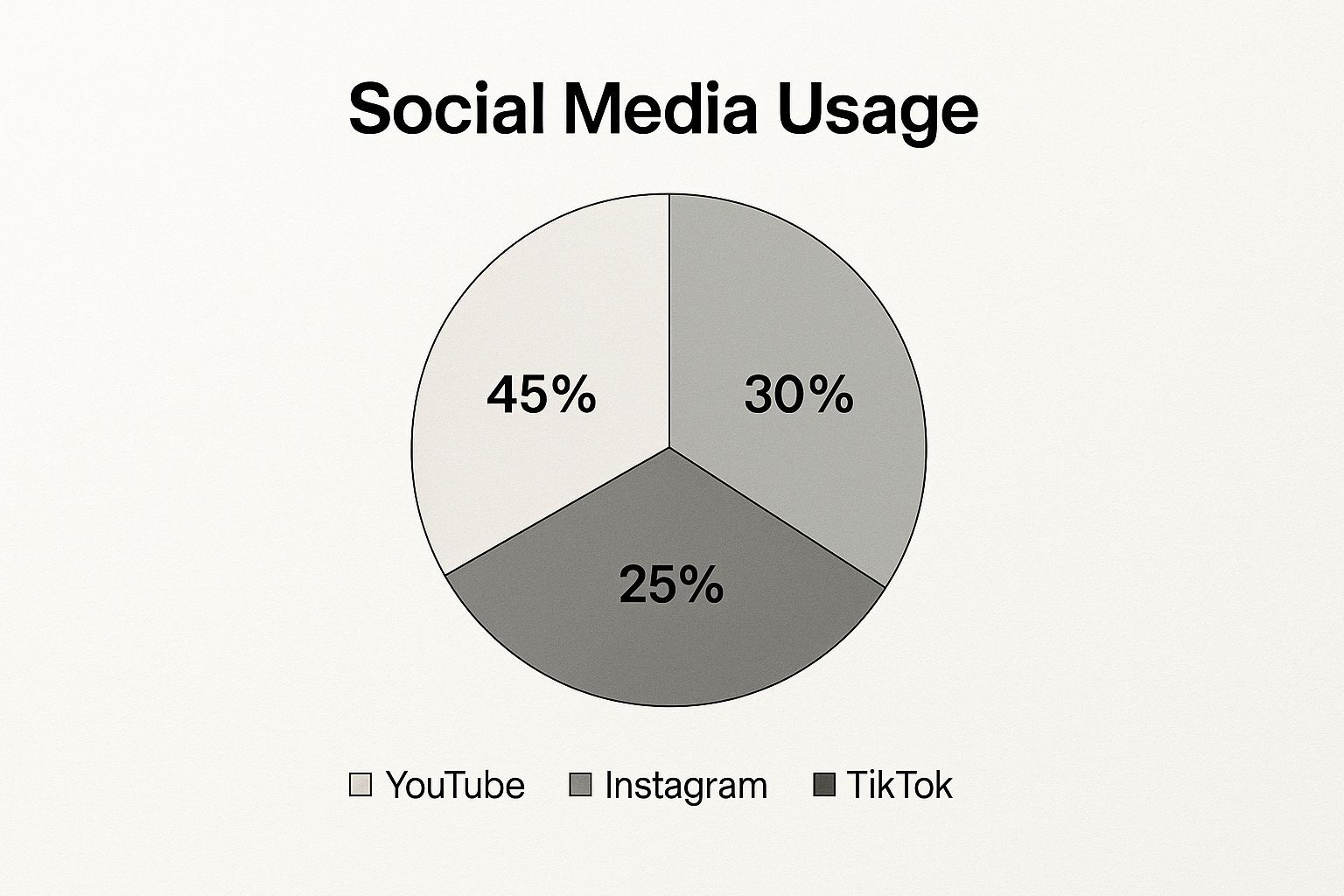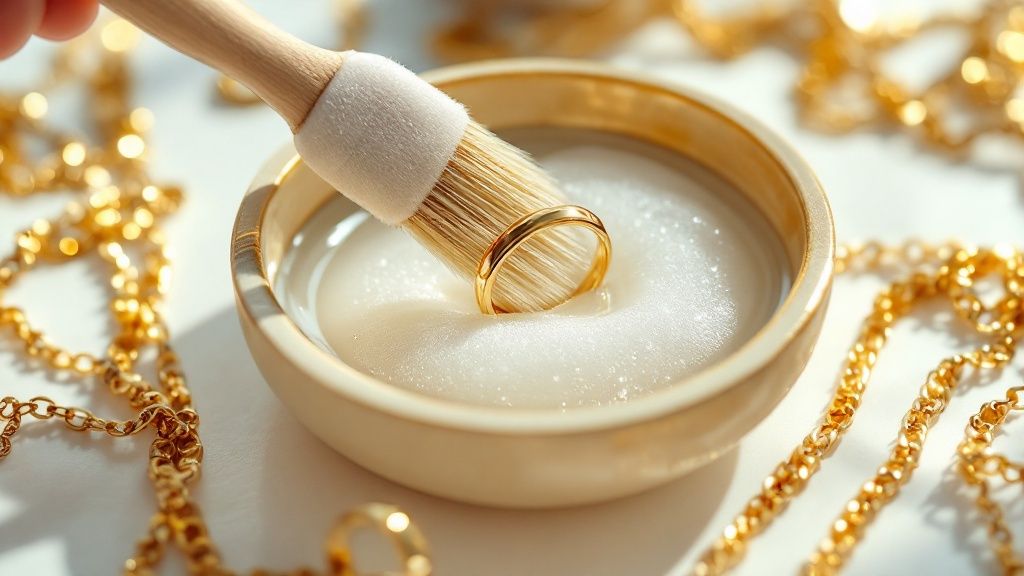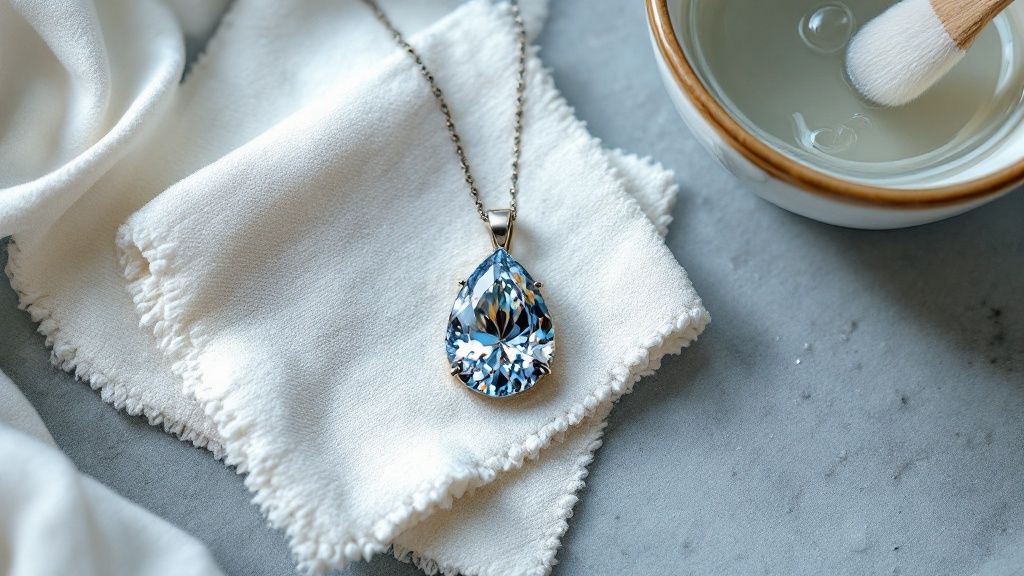How to Clean Jewelry at Home: Easy DIY Tips
- seanmawhinney
- May 28
- 11 min read
Why Most People Struggle With Jewelry Cleaning at Home
Maintaining the sparkle of our jewelry can often feel like a chore. We know it's important, but other tasks frequently take precedence. Why is keeping our jewelry clean such a struggle? Many of us simply aren't sure of the most effective cleaning methods, leading to procrastination and neglect.
Common Misconceptions About Jewelry Care
One common misconception is that a universal cleaning method works for all jewelry. This simply isn't true. Different metals and gemstones possess unique properties and react differently to various cleaning solutions. For instance, cleaning a sturdy gold chain requires a different approach than cleaning delicate pearls. This lack of knowledge often leads to improper cleaning, potentially damaging jewelry and diminishing its brilliance.
Many also believe that professional cleaning is the only way to achieve truly sparkling results. This perception, coupled with the perceived cost, can be daunting. As a result, some people avoid cleaning their jewelry altogether, allowing dirt and grime to accumulate. This ultimately dulls the shine and can lead to long-term damage.
The Reality of At-Home Jewelry Cleaning Habits
A survey conducted by Shane Co. reveals some interesting insights into jewelry cleaning habits. 25% of Americans clean their jewelry with soap and water, while 17% use a polishing cloth and 11% use commercial cleaners. This suggests a reliance on common household items rather than specialized cleaning products. The survey also found that 52% clean their jewelry only when it looks dirty, highlighting a lack of regular cleaning routines. Surprisingly, 1 in 6 respondents admitted to never thoroughly cleaning their jewelry, even though 28% acknowledge they should clean it more frequently. Discover more insights about jewelry cleaning habits.
The Importance of Establishing a Routine
This data reveals a disconnect between our intentions and actions regarding jewelry care. A consistent cleaning routine is crucial, not only for preserving the beauty of our jewelry but also for maintaining its value and ensuring its longevity. The buildup of dirt, oils, and lotions can damage precious metals and gemstones over time. Neglecting regular cleaning can lead to expensive repairs or even irreversible damage.
Proven Home Cleaning Methods That Actually Deliver Results
Cleaning your jewelry at home can be easier than you think. Often, the most effective methods use simple household items. This guide will walk you through some professional-recommended techniques to get jewelry store-worthy sparkle right in your kitchen.
The Power of Soap and Water
For many jewelry types, the best cleaning solution is simply warm water and mild dish soap. This gentle but powerful method is a classic for a reason. Warm water loosens dirt and grime, while the mild dish soap breaks down oils and residue. This combination cleans thoroughly without harsh chemicals that could damage delicate pieces. Learn more about gold jewelry cleaning: How to master gold jewelry cleaning.
Mastering the Brush Technique
While soap and water provide the cleaning power, a good brush is essential for those hard-to-reach spots and intricate details. A soft-bristled toothbrush, designated just for jewelry, is the ideal tool. Avoid hard-bristled brushes or anything abrasive, as these can scratch delicate surfaces. Gentle, circular motions will remove dirt and grime. Focus particularly on areas where buildup is common.

This infographic shows the essential tools for at-home jewelry cleaning: warm soapy water, a soft toothbrush, a microfiber cloth, cotton swabs, and your jewelry. It highlights how simple and accessible effective cleaning can be. These everyday items are all you need for sparkling jewelry.
Many people aren't sure about the best way to clean jewelry at home, sometimes using inappropriate household products. The Gemological Institute of America (GIA) recommends warm water, mild dish soap, and a soft brush for cleaning colored gems. This ensures gentle but effective cleaning. They also suggest using a soft cloth for drying and polishing to maintain shine and prevent water spots. For more details, see their recommendations here. This advice reinforces the effectiveness of simple cleaning solutions.
The Importance of Drying and Polishing
After cleaning, drying and polishing are key for a professional look. Pat your jewelry dry with a soft, lint-free cloth. Avoid paper towels or tissues, as these can leave fibers. For extra shine, gently polish the metal with a microfiber cloth. This removes any remaining water spots and restores brilliance.
Timing Is Key
Over-cleaning can damage jewelry, so a regular cleaning routine is important. Cleaning frequently worn pieces every two weeks is usually enough. Items worn less often can be cleaned monthly or as needed. Always check your jewelry for damage or loose stones before and after cleaning. This lets you catch any potential issues early and prevent more damage. With these easy methods, your jewelry will look its best for years to come.
To help you choose the best cleaning method for your jewelry, we've compiled a comparison table:
Home Jewelry Cleaning Methods Comparison: This table compares different DIY cleaning approaches, highlighting their effectiveness, safety, and best uses for various jewelry types.
Method | Materials Needed | Best For | Safety Level | Time Required |
|---|---|---|---|---|
Soap and Water | Warm water, mild dish soap, soft-bristled brush | Most jewelry, especially gold and gemstones | High | 5-10 minutes |
Polishing Cloth | Microfiber cloth | Metals like gold, silver, and platinum | High | 2-5 minutes |
Baking Soda Paste | Baking soda, water | Silver, avoiding gemstones | Medium | 10-15 minutes |
Key Insights: As the table shows, simple methods like soap and water are highly effective and safe for most jewelry types. While other methods exist, always consider the specific materials of your jewelry before cleaning. Regular cleaning, combined with proper drying and polishing, will keep your jewelry looking its best.
Safe Cleaning Approaches for Different Jewelry Types
As we've discussed, different jewelry materials require specific cleaning methods. What's safe for a gold necklace could damage a pearl ring. Understanding these nuances is key to preserving your jewelry's beauty and ensuring it lasts.
Cleaning Gold and Platinum
Gold and platinum are durable metals that can handle slightly more robust cleaning. The soap and water method works well. Soak your gold or platinum pieces in the solution for a few minutes to loosen dirt and grime.
For more stubborn buildup, a soft-bristled brush can be used with gentle, circular motions. It's important to avoid abrasive materials that could scratch the surface. Rinse thoroughly and pat dry with a lint-free cloth.
Caring for Silver Jewelry
Silver is known for tarnishing, a chemical reaction with sulfur in the air. While soap and water is suitable for regular cleaning, a specialized silver cleaner or polishing cloth may be needed for tarnish removal. More information can be found in our article about How to master silver jewelry cleaning at home. Handle silver carefully and avoid harsh chemicals like bleach.
Gentle Cleaning for Pearls and Opals
Pearls and opals are delicate gems requiring extra care. Never soak these stones. Instead, dampen a soft cloth with a mild soap solution and gently wipe each pearl or opal individually.
Avoid submerging them, as water can damage their delicate structure. After wiping, use a separate damp cloth to remove any soap residue and pat dry immediately with a soft, lint-free cloth.
Cleaning Gemstone Jewelry
Gemstone jewelry cleaning depends on the specific stone. While many gemstones can tolerate the soap and water method, others, like emeralds, are more vulnerable to damage from harsh chemicals and ultrasonic cleaners.
It's always best to consult a jeweler for cleaning advice, especially for delicate or valuable gemstones.
Antique and Costume Jewelry
Antique and costume jewelry often have special cleaning needs. Antique pieces may have fragile settings or sensitive materials. Costume jewelry can contain materials that react poorly to water or certain chemicals.
If you're unsure how to clean these types of jewelry, consult a professional jeweler to avoid damage. This will help protect their unique beauty and historical significance.
Learning to clean your jewelry at home not only saves money, but also lets you enjoy the sparkle of your treasured pieces more often. By following these guidelines, you can keep your collection looking beautiful for years to come.
Building Your Essential DIY Jewelry Cleaning Kit
Maintaining the sparkle of your jewelry doesn't have to require expensive professional cleanings. Assembling a DIY jewelry cleaning kit at home is a cost-effective way to keep your pieces looking their best. Having the right tools and solutions on hand empowers you to care for your jewelry whenever it needs a little refresh.
Essential Tools and Supplies
The foundation of your kit lies in a few simple tools, many of which you probably already own:
Soft-bristled brush: A new, soft-bristled toothbrush, dedicated solely to jewelry cleaning, is perfect for gentle scrubbing. This will lift away dirt and grime without scratching delicate surfaces.
Lint-free cloths: Microfiber cloths are excellent for drying and polishing. They leave jewelry sparkling and free from unsightly water spots. Avoid using paper towels or tissues, as these can scratch or leave residue.
Small bowls: Two small bowls will allow for soaking and rinsing your jewelry separately, preventing cross-contamination and ensuring a thorough clean.
Cotton swabs: Perfect for those hard-to-reach crevices, especially in intricate settings, cotton swabs provide a gentle touch for delicate pieces.
Choosing the Right Cleaning Solutions
Once you have your tools assembled, it's time to select the right cleaning solutions:
Mild dish soap: A staple in most jewelry cleaning routines, a few drops of mild dish soap in warm water creates a gentle yet effective cleaning agent.
Specialized cleaners (optional): For specific metals like silver, a commercial silver cleaner can help remove tarnish. Always choose a reputable brand and follow the product instructions carefully.
This image shows an efficiently organized jewelry cleaning kit, making at-home care convenient and effective. Ready access to dedicated tools and solutions encourages regular maintenance and protects your jewelry investment.

Organizing and Maintaining Your Kit
A well-organized kit makes the cleaning process smoother and more efficient. Store your supplies in a small container or box, keeping everything together and easily accessible. This also helps prevent your cleaning tools from being misplaced or used for other purposes. Remember to regularly replace your toothbrush and cloths to maintain optimal cleaning and avoid reintroducing dirt or grime.
Creating a Travel Kit
For jewelry care on the go, a smaller, travel-sized kit is invaluable. A small pouch containing travel-sized cleaning solutions, a miniature brush, and a microfiber cloth allows for quick and easy cleaning wherever you are. This can be particularly helpful when traveling to areas with different water quality, which could potentially affect your jewelry.
Establishing a Cleaning Schedule
Finally, establish a cleaning schedule that fits your lifestyle. The frequency of cleaning depends on how often you wear your jewelry. A good starting point for everyday pieces is cleaning every two weeks. Items worn less frequently can be cleaned monthly. Consistency is the key to preventing buildup and preserving the brilliance of your jewelry collection. Following these simple steps allows you to clean your jewelry effectively at home, keeping it sparkling for years to come.
Choosing Between DIY Care and Professional Services
Keeping your jewelry gleaming at home is a simple way to maintain its sparkle. Sometimes, however, professional services are a must. Understanding when to choose which approach can protect your valuable pieces and save you money. This section explores the best ways to care for your jewelry by finding a balance between DIY solutions and professional cleaning.
When To Clean at Home
Regular cleaning at home is perfect for keeping most jewelry looking its best. For example, cleaning gold and platinum pieces weekly with warm, soapy water and a soft brush is usually enough. This easy routine prevents the buildup of dirt, oils, and lotions that can dull their shine. At-home care also allows you to quickly polish tarnished silver or refresh gemstone jewelry between professional cleanings. Read also: How to prevent jewelry from tarnishing.
Recognizing the Limits of DIY
While cleaning at home works well for general maintenance, it has its limits. DIY methods may not be suitable for delicate gemstones, intricate settings, or antique pieces. For example, trying to clean a complex vintage ring with small diamonds at home could loosen the stones. Porous gemstones like pearls also require special care that goes beyond soap and water. This means some pieces benefit from the expertise and specialized equipment of professional jewelers.
The Benefits of Professional Cleaning
Professional jewelers use advanced tools like ultrasonic cleaners and steaming equipment. These tools reach crevices and remove stubborn dirt that at-home methods can’t. This is especially helpful for jewelry with hard-to-reach areas or intricate designs. Professionals also know how to clean different gemstones and metals safely, reducing the risk of damage. Plus, they can identify potential problems like loose prongs or worn settings, offering preventative maintenance that extends the life of your jewelry.
The Cost Factor: DIY vs. Professional
Professional cleaning has a cost, but consider it an investment in your jewelry’s longevity. The market for commercial jewelry cleaners is growing, showing consumer demand for professional-grade products. Factors like a rising upper-middle class contribute to this growth, despite the convenience of DIY. Home remedies are still a cost-effective choice, yet professional jewelers provide essential deep-cleaning services. Both approaches work together for comprehensive jewelry care. Learn more about jewelry cleaner market trends here.
Finding a Reputable Jeweler
When you choose a professional jeweler for cleaning or repairs, get recommendations from trusted sources or check with industry organizations. A reputable jeweler should have certified gemologists and experienced professionals. They should also clearly explain their cleaning methods and accurately assess needed repairs. This expertise is key to preserving the value and beauty of your jewelry.
Combining DIY and Professional Care
For the best results, combine regular at-home care with professional cleanings. This approach keeps your jewelry sparkling every day while ensuring regular deep cleaning and inspections. Integrating both methods will help maximize the lifespan and brilliance of your treasured pieces.

Critical Mistakes That Can Permanently Damage Your Jewelry
Cleaning your jewelry at home can restore its brilliance, but incorrect methods can cause irreparable harm. Understanding these common cleaning mistakes is vital for preserving your treasured pieces. This section explores those pitfalls and how to avoid them.
Harsh Chemicals: A Recipe for Disaster
One of the biggest mistakes is using harsh chemicals. Substances like chlorine bleach, abrasive cleaners, and even some common household cleaners can permanently discolor metals, erode protective finishes, and damage delicate gemstones. For example, bleach can pit gold and compromise the delicate structure of pearls. Always choose gentle cleaning solutions. Mild dish soap and warm water are safe for most jewelry.
The Dangers of Abrasive Materials
Another frequent error is using abrasive materials. Scrubbing jewelry with harsh sponges, steel wool, or even toothpaste can scratch surfaces, particularly on softer metals like gold and silver. These scratches dull the shine and detract from the overall beauty of your jewelry. Instead, use a soft-bristled brush, such as a dedicated toothbrush, for gentle cleaning that won't cause scratches.
Incorrect Techniques: More Harm Than Good
Even seemingly harmless techniques can create problems. Soaking porous gemstones like pearls or opals can cause water absorption. This weakens their structure and can lead to damage. Similarly, using boiling water on certain gemstones can cause them to fracture or crack. Always research the appropriate cleaning methods for specific gem types. Consult a professional jeweler if you are uncertain.
The Downside of Social Media Hacks
While social media offers a plethora of cleaning tips, be cautious of trendy "hacks." Many of these unverified methods can damage your jewelry. For instance, using baking soda and aluminum foil on silver can lead to over-cleaning and potential pitting. It's always best to stick with proven, professionally recommended cleaning methods.
Recognizing the Warning Signs
Knowing when your cleaning method isn't working is essential. Signs of damage include discoloration, scratches, or a dull, lackluster appearance. If you notice any of these signs, stop cleaning immediately and consult a jeweler. Early detection can prevent further damage and potentially save you from costly repairs.
To help illustrate some common mistakes and their consequences, take a look at the table below:
To summarize common mistakes, we've created this helpful table:
Jewelry Cleaning Mistakes to Avoid
Common Mistake | Potential Damage | Why It Happens | Safe Alternative |
|---|---|---|---|
Using harsh chemicals | Discoloration, pitting, structural damage | Misbelief that strong cleaners are more effective | Mild dish soap and warm water |
Abrasive materials | Scratches, dulling | Lack of awareness of material sensitivity | Soft-bristled brush |
Soaking porous gems | Cracking, weakening | Misunderstanding of gemstone properties | Wipe with a damp cloth |
Boiling water | Fractures, cracks | Belief that high temperatures disinfect | Warm or room temperature water |
Social media hacks | Over-cleaning, pitting, discoloration | Following untested or misleading online advice | Proven professional-recommended methods |
By understanding and avoiding these common cleaning mistakes, you can effectively clean your jewelry at home while preserving its beauty and value for years to come. For exquisite, high-quality jewelry pieces, explore the collection available at Panther De Luxe Shop.

Comments